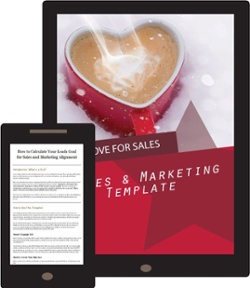No company is perfect, but it’s important to make sure you keep the spotlight on your strengths. One area in particular where performance can be improved is sales. This is a tricky arena, because no matter how good your sales team is, they will encounter setbacks, and it's up to all members of the organisation, from executives to sales engineers, to figure out together how to overcome them and keep moving forward when any one individual is seen struggling.
What makes a company successful is how they work together as a unified business unit. They have goals, KPIs, and metrics in place that everyone follows. They make sure their marketing teams are working with sales teams who, in turn, are working with members of all departments to ensure shared goals and values, which ultimately lead to a more successful business unit. And when it comes down to overcoming things like the usual challenges of sales and marketing, these companies essentially have all the "ingredients" they need at hand to overcome any obstacle placed in front of them.
Follow these steps to implement this at your company.
1. Identifying Qualified Prospects
Sales reps should contact leads who are a good fit - instead of just looking for new ones every day. They should concentrate on people who have already bought something but are also open to being persuaded and persuaded by your company again shortly. And sales reps need to be especially patient with first-time buyers, as they will take longer than those who have already purchased (on average) before deciding whether or not to buy your product or service again.
Typically demand generation is more effective at putting early-stage leads into a sales funnel because the product isn’t potentially ready for consideration yet and there isn’t time to give any meaningful amount of nurturing. That being said, new lead nurturing with pre-generated content allows for new prospects to be pulled through a buyer journey even when a product may not be inherently ready yet. To make this possible, one should take advantage of layering email campaigns and measuring qualifications to signal representatives when prospects are at their most willing to convert.
2. Responding To Prospects
Your message, no matter how you’re communicating with customers, has to be disruptive and stirring. To get prospects to respond, you have to have the right communication but it’s not enough to just send out a single communication. The goal is a series of communications that address the potential customer's challenges.
According to Top Performance in Sales Prospecting, it takes about eight contacts with a new prospect to get an initial meeting.
The automation of many of these tasks is now possible with tools like HubSpot. Automated workflows enable sales reps to speak with prospects who are ready to buy and nurture prospects who aren't quite ready.
Don't ask your customers to buy. Instead, be a helpful guide in the sales process. Provide solution-oriented content targeted to their specific needs so they feel comfortable and confident in their decision.
By delivering high-quality content to the right prospects at the right time, you will dramatically increase response rates to key messages and webinars/webinar recordings. Content is also a vital part of this process so make sure marketing knows what sales representatives need on hand to help close sales faster by presenting it in context during their call-to-action outreach programs.
3. Differentiating Yourself from Your Competitors
What could your sales reps do to help your company stand out? Develop relationships that matter. Customer contact represents your brand. Happy customers become brand ambassadors.
Become selfless and share your expert knowledge to demonstrate your commitment to helping them. Consider offering them suggestions for more suitable solutions if your business isn't the best fit. If you don't push for that sale, you're building trust in your company.
Sales are difficult at the best of times, but if you want to make sure that you're one of your customers' favorites, then follow through! Start with a new approach and a plan called "Follow Through". You have to get down from your high horse as a salesperson and start building relationships by emphasising communication. Listen more than you speak and ask them about their situation rather than telling them about yours. By showing empathy it shows them right off the bat that you have their interests at heart, or else why should they listen to anything else?
Salespeople must communicate very carefully what is important using careful words while not taking the power away from the prospect by becoming too pushy. If your prospects can see how much better they would be off with you while using careful detail backed up by facts, then this will build confidence in your brand and help you close more deals. Taking the time to show your prospects that you care means giving them results!
4. Having The Right Questions to Ask
Knowing what prospects want, need, and struggle with is possible by asking the right questions. Do not make an immediate pitch. This won't work. Instead, inquire whether and how you can assist your prospects.
A well-prepared sales team will ask the right questions. Don't limit yourself to a yes or no answer—a one-word response won't get you very far. Give your prospect a chance to respond before asking three questions at once. Allow each question to sit for a while before you ask the next one.
Neither wing it nor fail to prepare. Use a document that includes all the relevant questions. A content-to-question match is an excellent idea.
5. Maintaining Focus
As far as sales reps go, you've got to know what motivates them. Understanding the types of incentives and motivational tactics that are going to keep your team excited is important to keep them motivated but also to ensure you'll achieve your sales goals. It can be challenging for small business owners to find the time for coaching, particularly if you're managing on a day-to-day basis, but it's worth it when you consider the boost in morale and motivation that comes from empowering your managers to act as trainers for their teams.
6. Overcommitment To Administrative Tasks
Sales representatives are busy people and keeping track of their schedules can be quite challenging. Imagine all the back-and-forth emails with customers just to schedule one 30-minute meeting. It’s inefficient, time-consuming, and lacks conciseness. Sales enablement tools help sales managers devote their limited time to strategising more rather than planning meetings and tracking progress via emails or spreadsheets.
Tools such as meeting schedules, for example, enable prospects to instantly book time on your reps' calendars without having to send lengthy emails.
Furthermore, email templates can save your representatives' time. There is still a need to customise messages, but having a template to follow up on, recap calls, and more will help them be more efficient. Today, video tools such as Zoom allow sales reps and customers to meet face-to-face if traveling is not practical.
7. After-Sale Customer Relationship Management
A sales rep's job doesn't end with a signed contract. Maintaining trust is one of the most important aspects of a good relationship. Letting a prospect know they're valued can be the difference between retaining a client or losing them before they even get to make a purchase. Keep in mind that while closing an initial deal is exciting, it doesn't mean the salesperson should become lazy. As a sales rep, always make sure your client feels like they're being trusted and listened to. That's the best way to make sure they keep coming back.
Ensure your customers are happy by regularly checking in with them. Based on your customers' engagement levels, you can send customised emails to them via marketing automation.
The more you nurture your existing clientele, the more likely they are to stay loyal to your brand. Additionally, upselling a satisfied client is simpler. There is an advantage to upselling, which is that it can generate more revenue than acquiring new customers.
8. Effective Team Selling
The majority of sales teams do not effectively collaborate. Individuals tend to stick close to the employees they are most familiar with. Working on your own can have its perks, but there is a difference between working independently and being a lone wolf when it comes to sales. A team-oriented approach is a key to making sure that all of your bases are covered in terms of uncovering issues or obstacles that might require further research. Being an effective salesperson requires more than just knowing the product though, you must know how to work well in teams with other people and foster collaboration between employees involved in different aspects of the sales process such as product development, distribution, and customer service - something which is crucial if you want every person on your team working towards achieving common goals!
Lastly,
In the past, people have found that it’s difficult to ensure proper communication between the sales, marketing, and services teams. The marketing team would make changes that the sales team would not be aware of, and vice versa. This can lead to a disjointed selling process and a lack of customer satisfaction. It’s important to have regular communication between these teams, which can help to avoid this problem.




